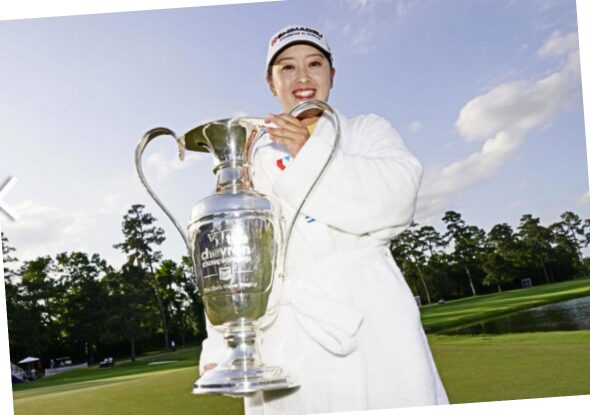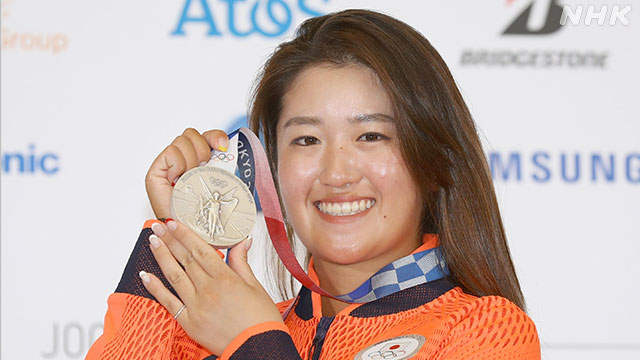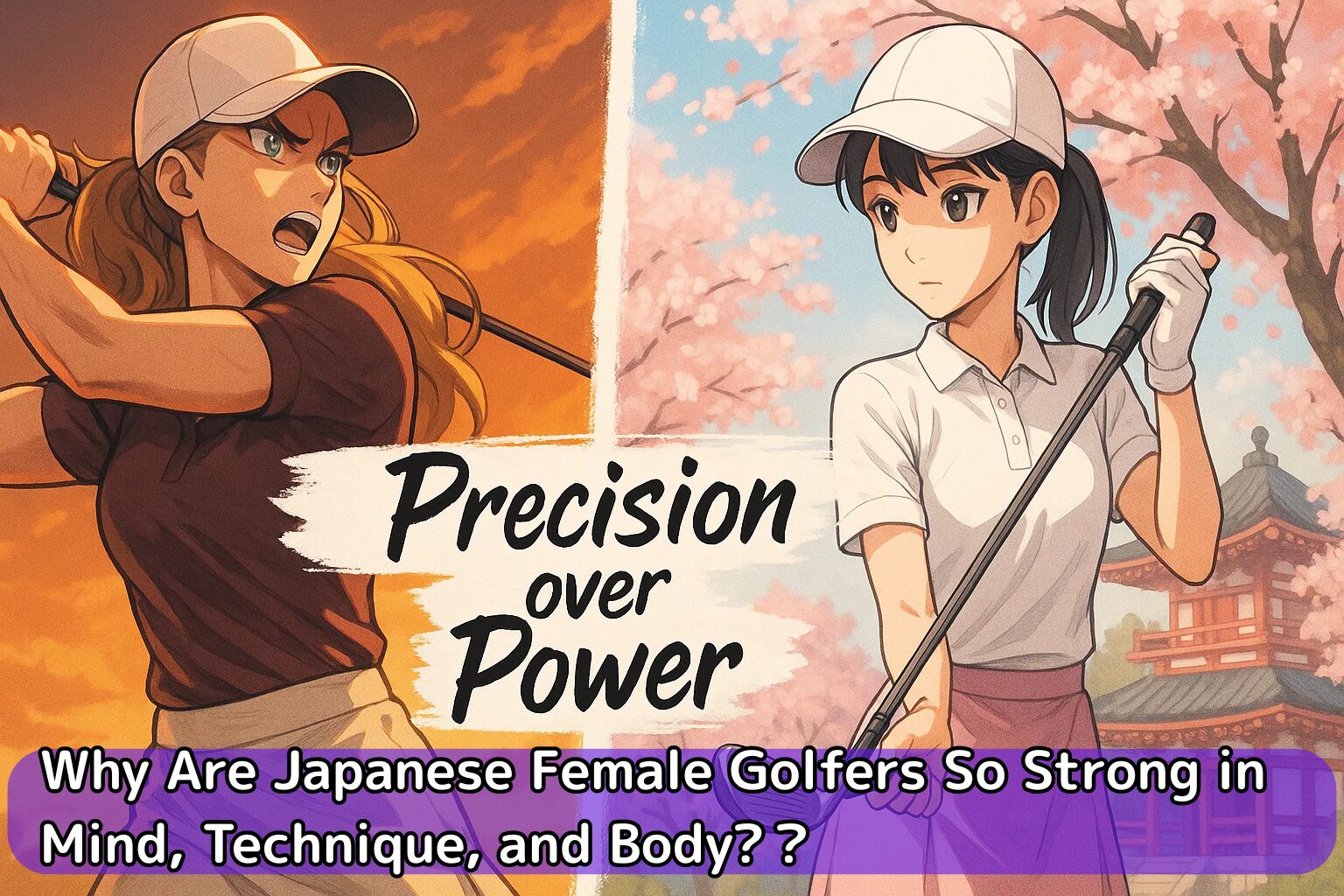Golf is a strange sport.
Miss a shot, and you suffer alone.
Hit a great one—and your opponent claps for you.
Seriously, what other sport does that?
Saying “Nice shot!” or “Great birdie!” to someone you’re competing against?
That, my friend, isn’t just sportsmanship—it echoes something deeper.
It echoes Bushido.
And if you’ve watched how Japanese women golfers carry themselves,
you’ll see it too.
“It begins with respect, and it ends with respect—that’s not just Kendo, you know.
Golf is the same.
It’s a game of courtesy… and of restraint.”
In the world of women’s professional golf,
a wave of small-statured Japanese players is challenging Western power golf—with quiet strength.
They can’t outdrive them.
They don’t overpower them.
But they win.
Because they don’t rely on muscle.
They rely on mind, technique, and body—unified.
And with that, they take control of the only truth that matters: the scorecard.
This article unpacks why Japanese female golfers are winning through mind, technique, and body—not just skill or strength.
By viewing golf through the lens of Bushido, we reveal the clear differences between Japanese and Western players.
“This isn’t just about technique.
If you’re struggling with your game, this might just change how you think about golf—starting today.
Now come on…
Let’s go find out what real strength looks like.”

🔶 What Is “Shin-Gi-Tai”? The Martial Art of Balance in Golf

This silhouette isn’t just art.
It’s a visual embodiment of the Shin-Gi-Tai mindset that lies beneath the quiet power of Japanese women golfers.
🔹 What Is “Shin-Gi-Tai”? A Core Principle Rooted in Japanese Martial Arts
You’ve probably heard the phrase “Shin-Gi-Tai”—even if you’re not into martial arts.
It’s long been the standard for measuring true strength in traditional Japanese disciplines.
- Shin (Mind): Mental strength, focus, and inner composure
- Gi (Skill): Technical ability, form, and repeatability of motion
- Tai (Body): Physical power, physique, flexibility, and endurance
 知ったかぶり社長
知ったかぶり社長“You think it’s all about the body? Nah.
True mastery starts with the mind, sharpens through skill, and is carried by the body.”
Only when all three—mind, skill, and body—are in balance can a player be called a true competitor.
If even one is missing, then victory, no matter how sweet, is just a matter of chance.
🔹 Why “Shin-Gi-Tai” Matters in Golf
So how exactly does Shin-Gi-Tai work in golf?
First, let’s get this straight:
Golf may look like a competition against others,
but 90% of the time—it’s a battle against yourself.
Unlike baseball or soccer, you’re not reacting to your opponent’s every move in real time.
No one’s rushing at you. No one’s shouting in your ear.
It’s just the ball, the club… and you.
And remember—golf isn’t a sprint.
It’s 18 holes a day, four days straight—72 holes of mental, technical, and physical balancing.
That’s not just a game.
It’s an endurance battle disguised as a sport.
Unlike any other ball game, golf tests your entire being—alone, for four relentless days.
🔹 Western vs Japanese Sports Culture: Two Ways of Competing
Now here’s where it gets interesting—
the cultural difference in how we define a win.
Western women golfers drain a putt with confidence, pump their fists, and play to the crowd.
And you know what? It’s compelling.
Because to them, sport is self-expression. That’s the philosophy they’re built on.
And then there are the Japanese players.
They approach each shot in silence—focused, composed.
Even after a birdie, smiles are subtle, celebrations modest.
Because for them, the goal isn’t to show off.
It’s to win with humility and to impress without words.
That’s their aesthetic. That’s their code.



“Only when mind, skill, and body align…
can you become a true master of quiet domination.”
The Data Prince’s Deep Dive


📘 “There may be mysterious wins, but never mysterious losses.
That’s not just a samurai saying—it’s golf logic, through and through.”
That phrase?
It originally comes from Kendan (剣談), a treatise on swordsmanship written by Seizan Matsuura—a daimyo and martial artist from Japan’s Edo period.
And here’s what it means:
“You might win by chance, but you never lose by accident.”
In other words, luck can sometimes explain success,
but failure always has a reason.
It means this:
A win might have a little luck behind it—but a loss?
There’s always a cause.
You don’t lose by accident. You lose because something went wrong.
Interestingly, this mindset wasn’t just for samurai.
It became the personal motto of legendary Japanese baseball manager Katsuya Nomura—
and today, you’ll hear it quoted in business seminars, classrooms, even coaching sessions.
And here’s the kicker:
It fits golf perfectly.
No need to adapt it.
It slides into golf like it was made for it.
Let’s break it down.
Say you hit a great shot—but the swing was technically flawed.
Maybe it just caught the sweet spot.
Maybe the wind gave you a gift.
In other words: sometimes, a good shot is just dumb luck in disguise.
But a bad shot?
That’s almost never luck.
There’s always a reason.
Mechanics, mindset, timing—something was off.
🔍 Common causes of a bad shot? Take your pick:
- he clubface was open.
- You lost your spine angle.
- Your body tensed up under pressure.
- Or maybe…
- You lost the battle before even swinging—mentally.
And that’s exactly why you’ll hear a phrase floating around the golf world:
🏌️♂️ “There may be mysterious nice shots—but there’s no such thing as a mysterious miss.”
In other words?
You might get lucky. But mistakes? They always leave a trail.
💬 The Data Prince says:
“We’ve all hit that one perfect shot with terrible form.
But ever shanked one and not known why?
Didn’t think so.”
This, my friends, is pure Seizan Matsuura Theory.
Golf is a sport where you learn more from your mistakes than your successes.
The players who truly improve?
They’re not the ones who celebrate a lucky shot.
They’re the ones who take a hard look at every miss—and figure out why it happened.
That’s why I believe this
In golf, Shin-Gi-Tai isn’t just about performance.
It’s the foundation for something deeper—the ability to recognize mistakes and correct them.
And that, right there?
That’s the real meaning behind “There may be mysterious wins, but never mysterious losses.”
🏌️♀️Shin-Gi-Tai Comparison: Western vs Japanese Women Golfers
| Category | Western Players | Japanese Players |
|---|---|---|
| Mind (Mental) | 🔹 Express emotions to build rhythm (fist pumps, vocal boosts)🔹 Quick reset after mistakes | 🔸 Suppress emotion to sustain focus🔸 Inner calm and reflection to regain balance |
| Skill (Technique) | 🔹 Aggressive play with distance and power🔹 Impact-focused swing mechanics | 🔸 Consistent routines and course management🔸 Precision shots and short-game finesse |
| Body (Physical) | 🔹 Superior strength and physique (tall, broad-shouldered)🔹 Explosive swing dynamics | 🔸 Flexibility, balance, and controlled form🔸 Beauty in rhythm and refined motion |
| Cultural Lens | 🔹 Sports as self-expression (positive self-talk)🔹 Bold celebration of success (American style) | 🔸 Rooted in Bushido values (respect, spacing, silence)🔸 “Strength in restraint” |
| Competitive Style | 🔹 Front-nine dominance with early momentum🔹 Win from the lead | 🔸 Late-round resilience and patience🔸 Clutch performance on the final day |
| Visual Impression | 🔹 Bold, powerful, aggressive presence | 🔸 Calm, elegant, and almost prayer-like precision in every shot |
🔷 Mind – Quiet Focus and Inner Strength: The Japanese Mental Game




🔹 Unshaken Faces, Unbreakable Focus: The Quiet Intensity of Japanese Pros
Just watching them makes you hold your breath.
Mao Saigo. Miyu Yamashita. Mone Inami—the Olympic silver medalist.


Their play is sharp, efficient, and composed.
Not a single wasted motion.
Not a flicker of emotion.
They make a birdie—no smile.
They drop a bogey—not a blink.
Ice on the surface, fire underneath.
If the phrase “quiet intensity” ever had a perfect embodiment…
it’s them.



“That’s what we call a poker face built for battle.
In high-level competition, showing emotion isn’t just a slip—
it’s giving your opponent an opening.”
This isn’t just about concentration.
It’s proof of something deeper—a trained mindset that refuses to let emotions dictate performance.
🔹Why Do Western Players Show Their Emotions So Openly?




Western women golfers? They’re a whole different story.
When they make a birdie, it’s a fist pump.
An eagle? They’re punching the sky.
And sometimes, they turn to the crowd with a big reaction—
that’s just how they do it.
But here’s the thing—this isn’t just for show.
It’s a mental technique known as “positive self-talk.”
A way to build energy, control momentum, and literally talk yourself into the zone.
“In American sports psychology, they’ve got a name for this stuff—‘positive self-talk.’
Fist pumps, shouting, even your facial expressions…
they’re not just emotions—they’re tools to hardwire a winning mindset.
Yup, in the U.S., your game face is literally part of your mental training!”
In other words, showing emotion shouldn’t be seen as a sign of weakness or losing control.
Rather, for many Western players, it functions as a mental switch—a deliberate way to activate their competitive energy and stay in the zone.
It’s not about being overwhelmed by emotion, but about using it strategically.
🔹 How a Player Handles Mistakes Reveals Their True Character
But let’s face it—golf is a game where things don’t go right most of the time.
The real question is this: how do you respond after a mistake?
And this is where a clear difference emerges—
in how Western and Japanese players use their minds under pressure.
Japanese players tend to absorb mistakes rather than react to them.
They reflect inwardly, calmly preparing for the next shot.
It’s not about processing emotions—it’s about digesting them, organizing them quietly within.
Western players, on the other hand, tend to switch emotions quickly.
They may express frustration or anger, but then it’s on to the next shot—mentally and physically.
That rapid reset becomes a key part of their ability to recover.



“It’s not about who’s right.
But there’s a massive difference between players who carry their mistakes…
and those who learn from them.
And Japanese women golfers?
They’ve mastered the art of learning.
That’s why they stay dangerous—even after a bogey.”
🔶Skill – Japanese Golf as a Craft: Precision Over Power
🔹 Repetition and Routine: The Hidden Power Behind Every Swing
When you watch a Japanese woman golfer swing, one thing becomes clear:
It’s as if they’re performing a kata—a practiced form, repeated with near-perfect precision.
And it makes perfect sense—
they repeat the same swing hundreds, even thousands of times.
Their commitment to eliminating even the slightest inconsistency?
That’s not just discipline.
That’s craftsmanship.
Even for those unfamiliar with golf, there’s something captivating about Yūri Yoshida’s swing.
From takeback to impact, she maintains a perfectly consistent tempo—
a rhythm so controlled, it quietly demands attention.
You can’t always explain it, but you feel it: something is different.


“Did you know the time from her routine to impact rarely varies by more than a second?
That’s not just focus—
that’s a pattern drilled into the body, not the mind.
We’re talking about precision that lives in muscle memory.”
Many Japanese women golfers play with the belief that the outcome is already decided before the swing is made.
It’s a mindset where preparation, routine, and focus become the true battleground—not the moment of contact.
The real battle happens before they step into address.
Once they’re in position, there’s no hesitation—only execution.
In many ways, it’s the golf equivalent of iaigiri: the mindset of drawing the sword only when you’re ready to strike.
🔹 Course Management Is All About Ma-ai – The Japanese Sense of Spacing


In late 2024, Yamashita claimed Medalist Honors at the LPGA Q-Series.
Standing just 150cm tall, she earned her path to glory through unshakable mental focus and technical mastery.
“Go for it, or play it safe?”
That single decision can make the difference between a great round and a disaster.
Japanese players excel here as well.
They read everything—wind direction, green firmness, the slope of the lie—
and do so with the subtle awareness of measuring ma-ai before each shot.
Take Miyu Yamashita, for example—her course management is textbook.
She doesn’t just aim at the pin; she places the ball where she wants it to stop.
That level of precision is how she consistently controls her score.



“An old master once said, ‘You don’t chase scores—you shape them.’
And when you watch Miyu Yamashita play, you finally get what that means.
It’s not luck. It’s intentional, surgical precision.”
🔹 In Contrast: The Western Game of Power and Impact
Of course, Western players possess incredible skill as well.
But their technique is often backed by a style built on overwhelming power—a game that forces its way through.
- Apply pressure with sheer driving distance
- Go for the green in two on long par 5s
- Attack the pin aggressively on approach shots
Power-driven golf.
And how about the Japanese players?
They don’t overpower the course—but they don’t miss.
They may not bomb it off the tee.
But they hit the fairway.
If they miss the green, they get up and down.
And if they can’t get it close, they make the putt.
What truly sets Japanese players apart is their precision in putting and short game—
a weapon that many Western players simply don’t have in their arsenal.
The real strength of Japanese players lies in how they rebuild their game after a mistake.
They don’t rely on power—they win with control.
And that’s the true essence of technique as a weapon.
✅ Technique isn’t about raw power—
it’s about the ability to restore, refine, and control.
And to master that?
It takes unwavering commitment to form and repetition, day after day.
In the world of golf, the craftsmanship of Japanese players isn’t just competitive—
it’s an art form on a global stage.
🟡 Body – Beyond Strength: Redefining What “Physical” Means in Golf
🔹Not Long, But Still Winning? A Question Western Fans Keep Asking
“Wait—how?
She’s so small… so how is she winning?”
It’s a question you’ll often hear from Western fans watching LPGA tournaments.
Around 150cm tall, slim builds, and driving distances often under 250 yards—
yet somehow, five Japanese players finish in the top 10.
That’s not supposed to happen… and yet, it does.
To many Western fans, it feels like an unexplainable phenomenon.



“All they see is body size.
But in golf? It’s the unseen forces that decide who wins.”
🔹 Flexibility, Balance, and Repeatability: The Real Deciders in Golf
The strength of Japanese women golfers lies in their exceptional flexibility and core balance.
Their axis stays centered.
When the club stops at the top, it drops straight back down—to the exact same spot.
That’s not just good form.
That’s body control—a different level of physical quality altogether.
And above all, they engrave each movement into their bodies through relentless repetition.
It’s what you’d call a craftsman’s form—honed over time, not just taught.
Miyu Yamashita’s swing, measured by TrackMan, shows a club path and face angle variation of less than ±1 degree.
That level of consistency means her mechanics are remarkably stable.
In other words, her body is built not just for swinging—but for controlling the score.
🔹 The Beauty of Movement: Breath, Rhythm, and Ma-ai in Motion
Another defining trait of Japanese players lies in their ability to control ma—the sense of timing and space that flows through their movements.
From the way they approach the ball, to the tempo of their takeaway, even the speed at which they walk—
every element is governed by their own internal rhythm.
Nothing is rushed. Nothing is out of sync.
This mirrors the concept of “regulating the breath” in martial arts.
It’s the art of tuning mind, technique, and body in harmony—
all in preparation for that one perfect moment: “This is it.”



“Even Tiger said it—‘You lose your tempo, you lose the match.’
When your breath and your motion fall out of sync,
your shot follows right behind.
Simple? Yeah.
But that’s the truth.”
This sense of ma-ai—of spacing and timing—is something rarely seen among Western players.
And that’s precisely why Japanese golfers move with a quiet intensity.
Their presence speaks, even when they don’t.
✅ Conclusion
The body in golf isn’t about muscle mass—
it’s a reflection of intelligence over motion.
It’s a hidden form of physical excellence that can only be earned
through repetition of form and deep internal awareness.
that’s more powerful than raw talent.
“You know Michael Phelps, right?
The guy’s 193cm tall, with an unusually long torso, massive shoulders, and giant hands and feet.
Basically… his body was built for water.
We’re talking about evolutionary optimization for swimming.”
Normally, someone that tall would be built for track—long legs, lean stride.
But Phelps? He’s different.
His long torso gives him natural buoyancy, and his oversized hands and feet make it easy to move through water.
It’s like his body was designed to function underwater.
“Now imagine if he’d chosen track instead.
Sure, maybe he’d have set some records…
but would anyone remember him?
Probably not.”
“Here’s the thing—
the body isn’t just something you train.
It’s something you’ve got to use in the right arena.
That’s where its true value shows.”
That’s why Japanese athletes choose sports that suit their strengths—
and even with smaller frames, they find their own path to victory and polish it to perfection.
That’s what it truly means to master the body you’ve been given.
📘 Book Recommendation
Atomic Habits by James Clear isn’t just a book about self-improvement—
it’s a blueprint for building the right habits, maximizing your natural strengths,
and choosing the environment where your body and mind perform best.
From elite athletes to everyday routines, this book breaks down how small choices lead to big outcomes.
If you’re serious about mastering your game—on or off the course—this one’s a must-read.



It’s not about talent—it’s about form.
And form?
It’s built through the small wins of daily habit.
Phelps. Yamashita.
They didn’t just get lucky—they got consistent.
🏁 Conclusion: Why Japanese Women Golfers Win Through “Mind, Skill, and Body”
What’s happening right now in the world of women’s golf?
On the LPGA Tour—once dominated by the mantra “You can’t win if you don’t hit long,”
small-statured Japanese players are quietly, yet steadily, racking up victories.
They’re not overpowering courses with brute strength.
Instead, they’re producing results through a style of golf that feels almost like martial arts—
a game of harmony between mind, technique, and body.
✅ Mind – The ability to absorb pressure without breaking
✅ Skill – Repeatable technique and smart course management
✅ Body – Fluid motion powered by flexibility, balance, and rhythm
True strength doesn’t come from size.
It comes from a perfect balance of mind, technique, and control.
- The era of winning through physical strength alone is over.
- Golf has proven itself to be a sport of complete human character.
- Could the martial arts mindset be the new standard for the modern game?
“Turns out, golf really is a sport of full character.
You don’t become a pro by just swinging hard.
It takes training the mind, the skill, and the body—
and stacking them up, day after day.”



“Listen up—
‘I can’t win because I don’t hit long’?
That excuse ends today.
Only those who master control can master the score.
Golf?
It’s not just a sport anymore—
it’s martial arts in motion.”
✅Maybe your golf—and even your life—starts to change
when you begin to focus on mind, skill, and body.
So start with this:
find your form.
And make it yours.















コメントはこちら